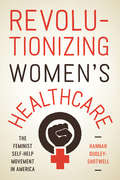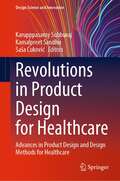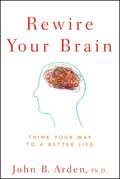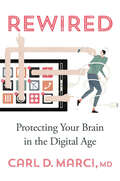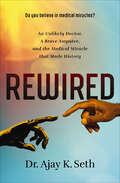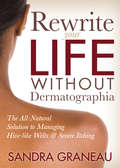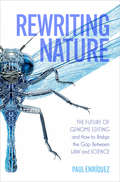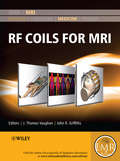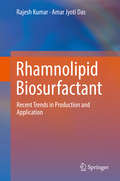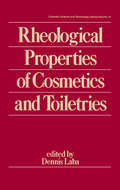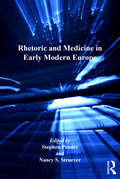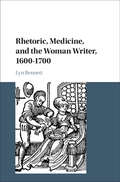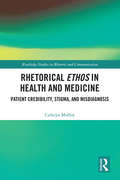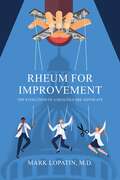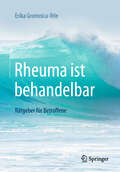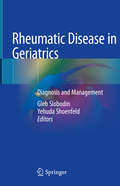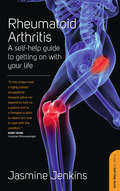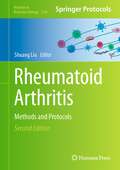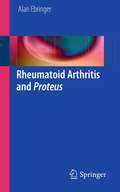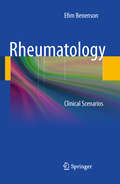- Table View
- List View
Revolutionizing Women's Healthcare: The Feminist Self-Help Movement in America
by Hannah Dudley-ShotwellRevolutionizing Women’s Healthcare is the story of a feminist experiment: the self-help movement. This movement arose out of women’s frustration, anger, and fear for their health. Tired of visiting doctors who saw them as silly little girls, suffering shame when they asked for birth control, seeking abortions in back alleys, and holding little control over their own reproductive lives, women took action. Feminists created “self-help groups” where they examined each other’s bodies and read medical literature. They founded and ran clinics, wrote books, made movies, undertook nationwide tours, and raided and picketed offending medical institutions. Some performed their own abortions. Others swore off pharmaceuticals during menopause. Lesbian women found “at home” ways to get pregnant. Black women used self-help to talk about how systemic racism affected their health. Hannah Dudley-Shotwell engagingly chronicles these stories and more to showcase the creative ways women came together to do for themselves what the mainstream healthcare system refused to do.
Revolutions in Product Design for Healthcare: Advances in Product Design and Design Methods for Healthcare (Design Science and Innovation)
by Karupppasamy Subburaj Kamalpreet Sandhu Saša ĆukovićThis book coherently presents advances in design principles, processes, and methods in healthcare product design. It captures the implications of technological advances on designing healthcare products especially when market and societal needs pull each other in opposite directions. The contents focus on innovative design thinking processes and methods in developing healthcare products, applications of digital technologies in healthcare product design, amalgamation of artificial intelligence and design thinking for healthcare product design and quality, sustainability, and regulatory aspects in the design process. This book is a useful reference for those in the industry and academia.
Rewire Your Brain: Think Your Way to a Better Life
by John B. ArdenHow to rewire your brain to improve virtually every aspect of your life-based on the latest research in neuroscience and psychology on neuroplasticity and evidence-based practices Not long ago, it was thought that the brain you were born with was the brain you would die with, and that the brain cells you had at birth were the most you would ever possess. Your brain was thought to be "hardwired" to function in predetermined ways. It turns out that's not true. Your brain is not hardwired, it's "softwired" by experience. This book shows you how you can rewire parts of the brain to feel more positive about your life, remain calm during stressful times, and improve your social relationships. Written by a leader in the field of Brain-Based Therapy, it teaches you how to activate the parts of your brain that have been underactivated and calm down those areas that have been hyperactivated so that you feel positive about your life and remain calm during stressful times. You will also learn to improve your memory, boost your mood, have better relationships, and get a good night sleep. Reveals how cutting-edge developments in neuroscience, and evidence-based practices can be used to improve your everyday life Other titles by Dr. Arden include: Brain-Based Therapy-Adult, Brain-Based Therapy-Child, Improving Your Memory For Dummies and Heal Your Anxiety Workbook Dr. Arden is a leader in integrating the new developments in neuroscience with psychotherapy and Director of Training in Mental Health for Kaiser Permanente for the Northern California Region Explaining exciting new developments in neuroscience and their applications to daily living, Rewire Your Brain will guide you through the process of changing your brain so you can change your life and be free of self-imposed limitations.
Rewired: Protecting Your Brain in the Digital Age
by Carl D. MarciLiving in an age of digital distraction has wreaked havoc on our brains—but there’s much we can do to restore our tech–life balance. We live in a world that is always on, where everyone is always connected. But we feel increasingly disconnected. Why? The answer lies in our brains. Carl D. Marci, MD, a leading expert on social and consumer neuroscience, reviews the mounting evidence that overuse of smart phones and social media is rewiring our brains, resulting in a losing deal: we are neglecting the relationships that sustain us and keep us healthy in favor of weaker and more ephemeral ties. The ability to connect and form strong social bonds is fundamental to human experience and emerged through unique structures in our brains. But ever-more-powerful technologies and ubiquitous access to media have hijacked our need to connect intimately and emotionally with others. The quick highs of clicking “like” and swiping right overstimulate the same neurological reward centers associated with social relationships. The habits that accompany our digital lifestyles are putting tremendous pressure on critical components of the brain associated with attention, emotion, and memory, changing how we process information and altering how we communicate and relate, even at a physiological level. As a psychiatrist working at the forefront of research on the impact of digital technology, Marci has seen this transformation up close and developed a range of responses. Rewired provides scientifically supported solutions for everyone who wants to restore their tech–life balance—from parents concerned about their children’s exposure to the internet to stressed workers dealing with the deluge of emails and managing the expectation of 24/7 availability.
Rewired: An Unlikely Doctor, a Brave Amputee, and the Medical Miracle That Made History
by Ajay K. SethA raccoon bite on the arm doesn&’t seem that serious, but it soon becomes a life-or-death medical crisis for Melissa Loomis. After days of treatment for recurring infection, it becomes obvious that her arm must be amputated. Dr. Ajay Seth, the son of immigrant parents from India and a local orthopaedic surgeon in private practice, performs his first-ever amputation procedure. In the months that follow, divine intervention, combined with Melissa&’s determination and Dr. Seth&’s disciplined commitment and dedication to his patients, brings about the opportunity for a medical breakthrough that will potentially transform the lives of amputees around the world.Rewired is the inspirational, miraculous story of Dr. Seth&’s revolutionary surgery that allows Melissa to not just move a prosthetic arm simply by thinking, but to actually feel with the prosthetic hand, just as she would with her natural arm. This resulted in what others have recognized as the world&’s most advanced amputee, all done from Dr. Seth&’s private practice in a community hospital, using a local staff, and with no special training or extensive research funding.
Rewrite Your Life Without Dermatographia: The All-Natural Solution to Managing Hive-like Welts & Severe Itching
by Sandra GraneauIn Rewrite Your Life Without Dermatographia, those who suffer from severe itching that won’t go away learn new ways to control their symptoms. Those who suffer from severe and endless itching know the real cost of living with a skin condition: from the medical bills to confidence at work. In Rewrite Your Life Without Dermatographia, Sandra Graneau helps readers identify what triggers their symptoms and get them under control. This all-natural guide for healthy skin is the most comprehensive resource for professional women living with dermatographia. In this guide, readers learn the possible trigger for their symptoms, tools to help them overcome their symptoms’ trigger, and so much more. Within Rewrite Your Life Without Dermatographia, readers finally learn to take back control of their body and life.
Rewriting Nature: The Future of Genome Editing and How to Bridge the Gap Between Law and Science
by Paul EnríquezHistory will mark the twenty-first century as the dawn of the age of precise genetic manipulation. Breakthroughs in genome editing are poised to enable humankind to fundamentally transform life on Earth. Those familiar with genome editing understand its potential to revolutionize civilization in ways that surpass the impact of the discovery of electricity and the development of gunpowder, the atomic bomb, or the Internet. Significant questions regarding how society should promote or hinder genome editing loom large in the horizon. And it is up to humans to decide the fate of this powerful technology. Rewriting Nature is a compelling, though-provoking interdisciplinary exploration of the law, science, and policy of genome editing. The book guides readers through complex legal, scientific, ethical, political, economic, and social issues concerning this emerging technology, and challenges the conventional false dichotomy often associated with science and law, which contributes to a growing divide between both fields.
Rewriting the American Soul: Trauma, Neuroscience and the Contemporary Literary Imagination (Routledge Interdisciplinary Perspectives on Literature)
by Anna ThiemannRewriting the American Soul focuses on the political implications of psychoanalytic and neurocognitive approaches to trauma in literature, their impact on cultural representations of collective trauma in the United States, and their subversive appropriation in pre- and post-9/11 fiction. Anna Thiemann connects cutting edge trauma theory with the historical context from which it emerged and shows that contemporary novels encourage us to reflect critically on the cultural meanings and political uses of trauma. In doing so, it contributes to a new generation of trauma scholarship that challenges the dominant paradigm in literary and cultural studies. Moreover, the book intervenes in current debates about the relationship between literature and neuroscience insisting that the so-called neuronovel scrutinizes scientific developments and their political ramifications rather than adopting and translating them into aesthetic practices.
RF Coils for MRI
by John R. Griffiths J. Thomas VaughanThe content of this volume has been added to eMagRes (formerly Encyclopedia of Magnetic Resonance) - the ultimate online resource for NMR and MRI. To date there is no single reference aimed at teaching the art of applications guided coil design for use in MRI. This RF Coils for MRI handbook is intended to become this reference. Heretofore, much of the know-how of RF coil design is bottled up in various industry and academic laboratories around the world. Some of this information on coil technologies and applications techniques has been disseminated through the literature, while more of this knowledge has been withheld for competitive or proprietary advantage. Of the published works, the record of technology development is often incomplete and misleading, accurate referencing and attribution assignment being tantamount to admission of patent infringement in the commercial arena. Accordingly, the literature on RF coil design is fragmented and confusing. There are no texts and few courses offered to teach this material. Mastery of the art and science of RF coil design is perhaps best achieved through the learning that comes with a long career in the field at multiple places of employment...until now.RF Coils for MRI combines the lifetime understanding and expertise of many of the senior designers in the field into a single, practical training manual. It informs the engineer on part numbers and sources of component materials, equipment, engineering services and consulting to enable anyone with electronics bench experience to build, test and interface a coil. The handbook teaches the MR system user how to safely and successfully implement the coil for its intended application. The comprehensive articles also include information required by the scientist or physician to predict respective experiment or clinical performance of a coil for a variety of common applications. It is expected that RF Coils for MRI becomes an important resource for engineers, technicians, scientists, and physicians wanting to safely and successfully buy or build and use MR coils in the clinic or laboratory. Similarly, this guidebook provides teaching material for students, fellows and residents wanting to better understand the theory and operation of RF coils.Many of the articles have been written by the pioneers and developers of coils, arrays and probes, so this is all first hand information! The handbook serves as an expository guide for hands-on radiologists, radiographers, physicians, engineers, medical physicists, technologists, and for anyone with interests in building or selecting and using RF coils to achieve best clinical or experimental results.About EMR Handbooks / eMagRes Handbooks The Encyclopedia of Magnetic Resonance (up to 2012) and eMagRes (from 2013 onward) publish a wide range of online articles on all aspects of magnetic resonance in physics, chemistry, biology and medicine. The existence of this large number of articles, written by experts in various fields, is enabling the publication of a series of EMR Handbooks / eMagRes Handbooks on specific areas of NMR and MRI. The chapters of each of these handbooks will comprise a carefully chosen selection of articles from eMagRes. In consultation with the eMagRes Editorial Board, the EMR Handbooks / eMagRes Handbooks are coherently planned in advance by specially-selected Editors, and new articles are written (together with updates of some already existing articles) to give appropriate complete coverage. The handbooks are intended to be of value and interest to research students, postdoctoral fellows and other researchers learning about the scientific area in question and undertaking relevant experiments, whether in academia or industry.Have the content of this Handbook and the complete content of eMagRes at your fingertips! Visit: www.wileyonlinelibrary.com/ref/eMagResView other eMagRes publications here
Rhamnolipid Biosurfactant: Recent Trends in Production and Application
by Rajesh Kumar Amar Jyoti DasThis book highlights the recent developments on rhamnolipid biosurfactant, its properties, role on the natural environment and various applications. Recently, it has shown promising application in Environment, Agriculture, food, petroleum, and pharmaceutical industries due to its environment-friendly and easily degradable nature. The book emphasizes on the various techniques that are utilized for the detection and isolation of rhamnolipid biosurfactant from microorganisms. It highlights the various aspects of the rhamnolipid biosurfactants including structural characteristics, production, and its application. The book presents the current knowledge and the latest advances in the function-based metagenomics strategies to facilitate the exploration of the novel biosurfactants.
Rheological Properties of Cosmetics and Toiletries (Cosmetic Science and Technology)
by Dennis LabaThis volume in the Cosmetic Science and Technology series covers the important rheological aspects of cosmetic and toiletry formulations, including theoretical physical chemistry, instrumentation and measuring techniques, raw materials and stability predictions. The work discusses the specific rheological requirements of nail polish, antipersirants and deodorants, dentifrices, hair care products, creams and lotions.
Rhetoric and Medicine in Early Modern Europe (Literary And Scientific Cultures Of Early Modernity Ser.)
by Nancy S. StrueverThrough close analysis of texts, cultural and civic communities, and intellectual history, the papers in this collection, for the first time, propose a dynamic relationship between rhetoric and medicine as discourses and disciplines of cure in early modern Europe. Although the range of theoretical approaches and methodologies represented here is diverse, the essays collectively explore the theories and practices, innovations and interventions, that underwrite the shared concerns of medicine, moral philosophy, and rhetoric: care and consolation, reading, policy, and rectitude, signinference, selfhood, and autonomy-all developed and refined at the intersection of areas of inquiry usually thought distinct. From Italy to England, from the sixteenth through to the mid-eighteenth century, early modern moral philosophers and essayists, rhetoricians and physicians investigated the passions and persuasion, vulnerability and volubility, theoretical intervention and practical therapy in the dramas, narratives, and disciplines of public and private cure. The essays are relevant to a wide range of readers, including cultural, literary, and intellectual historians, historians of medicine and philosophy, and scholars of rhetoric.
Rhetoric, Medicine, and the Woman Writer, 1600–1700
by Lyn BennettHow did physicians come to dominate the medical profession? Lyn Bennett challenges the seemingly self-evident belief that scientific competence accounts for physicians' dominance. Instead, she argues that the whole enterprise of learned medicine was, in large measure, facilitated by an intensely classical education that included extensive training in rhetoric, and that this rhetorical training is ultimately responsible for the achievement of professional dominance. Bennett examines previously unexplored connections among writers and genres as well as competing livelihoods and classes. Engaging the histories of rhetoric, medicine, literature, and culture throughout, she goes on to focus specifically on the work of women who professed as well as practiced medicine. Pointing to some of the ways women's writing shapes realities of body, mind, and spirit as it negotiates social, cultural, and professional ideologies of gender, this book offers an important corrective to some long-held beliefs about women's role in early modern discourse.
Rhetorical Ethos in Health and Medicine: Patient Credibility, Stigma, and Misdiagnosis (Routledge Studies in Rhetoric and Communication)
by Cathryn MolloyThis book explores rhetorical ethos and its ongoing role in patients’ credibility and in misdiagnoses stemming from gender, race and class-based biases. Drawing on the concept of ethos as a theoretical framework, it explores health and mental illness across different conditions and across different methodological approaches. Extending work on ethos in clinical encounters and public discourse about biomedicine and presenting new research on the rhetoric of mental health, stigma and mental illness, the book explores how bias in clinical settings can lead to symptoms labelled "in the patient’s head" masking treatable medical problems. This notable contribution to the rhetoric of health and medicine will be of interest to all researchers and graduate students of rhetoric and composition studies, rhetoric of health and medicine, disability studies, medical humanities, communication, and psychology.
Rheum for Improvement: The Evolution of a Health-Care Advocate
by Mark LopatinRheum for Improvement is a physician’s account of how corporate medicine has transformed health care from a human interaction between a patient and their physician into a business transaction between a consumer and a provider. It is also a personal story of how frivolous legal action triggered that physician to become an outspoken advocate for health-care reform. It will be of interest to anyone who interacts with our health-care system, but especially physicians, who must navigate bureaucratic obstacles on a daily basis.
Rheuma ist behandelbar: Ratgeber Für Betroffene
by Erika Gromnica-IhleRheuma – was jetzt? Das Buch klärt verständlich auf, welche Formen es gibt, an welchen Symptomen die Krankheit zu erkennen ist und warum jemand erkrankt. Erfahren Sie, wie man Rheuma behandeln kann, was Ihnen hilft und was gut tut. Nach den ersten Anzeichen und der Diagnose des Arztes stellen sich dem Patienten viele Fragen, die dieses Buch beantwortet. Lassen Sie sich motivieren, mit der Krankheit leben zu lernen. So werden Sie sicher im Umgang mit Ihrem Körper und im Dialog mit Ihren Behandlern. Nehmen Sie Ihre Zukunft mit Rheuma selbst in die Hand.
Rheumatic Disease in Geriatrics: Diagnosis and Management
by Gleb Slobodin Yehuda ShoenfeldThis book provides a practical guide to the diagnosis and management of rheumatic disease in geriatric patients. It details information on the effect of ageing on musculoskeletal and immune systems and specifies impact of a variety of inflammatory and degenerative rheumatic disorders on the elderly. The clinical diagnostic approach to an older individual with musculoskeletal complaints is a cornerstone of this book, which includes also insights into the most important comorbidities for this age and discusses in depth available treatments and rehabilitation tools. The symptoms, imaging features and recommendations on the interpretation of specific laboratory tests for rheumatic diseases in geriatrics are also covered. This book encompasses traditionally associated with older age conditions including temporal arteritis, polymyalgia rheumatica, osteoarthritis, as well as common systemic autoimmune diseases that can produce atypical manifestations in the elderly. It will enable the readers to develop a thorough understanding of how to deal with these patients in their clinical practice. Rheumatic Disease in Geriatrics: Diagnosis and Management systematically describes how to diagnose and treat geriatric patients with a variety of rheumatic conditions and is a valuable resource for all medical professionals involved.
Rheumatic Diseases and Syndromes Induced by Cancer Immunotherapy: A Handbook for Diagnosis and Management
by Maria E. Suarez-Almazor Leonard H. CalabreseWith the increasing use of immune checkpoint inhibitors (ICI) across various cancers, the trends for indication at earlier stages, and the use of combination immunotherapy, the frequency of ICI-induced immune-related adverse events (irAE) is expected to grow substantially. Management of these irAE is challenging as it requires not only consideration of the toxicity but also risk-benefit ratios with respect to the primary cancer. Several rheumatic irAE have been reported with ICI therapy including arthritis, myositis, polymyalgia-like syndromes, sicca/Sjogren-like manifestations, and several other less common systemic autoimmune features commonly associated with connective tissue disease. This handbook provides clinicians with a comprehensive overview of the management of rheumatic irAE that develop from cancer immunotherapy. It focuses on the irAE seen with ICI, the most frequently used agents in treating cancer. It provides an overview of cancer immunology, immunotoxicity, and immunotherapies such as ICI, cytokine-based therapy, and CART. It examines the epidemiology, clinical manifestations, diagnosis, differential diagnosis, and treatment of a variety of rheumatic immune-related adverse events arising from these therapies. Chapters also cover cancer immunotherapy in patients with preexisting rheumatic diseases such as inflammatory arthritis and other connective tissue disorders. The book helps clinicians to distinguish the current types of cancer immunotherapy and general toxicity patterns, recognize and diagnose rheumatic clinical syndromes, understand the pathogenesis of irAE, and consider risk–benefit ratios when managing patients with rheumatic irAE.Rheumatic Diseases and Syndromes Induced by Cancer Immunotherapy is an essential resource for physicians and related professionals, residents, fellows, graduate students and nurses alike in rheumatology, clinical immunology, oncology, and internal medicine.
Rheumatoid Arthritis: A Self-help Guide To Getting On With Your Life
by Jasmine JenkinsThis book will enable you to: * Understand more about Rheumatoid Arthritis and the medication involved * Reduce the pain that you experience * Use joint protection techniques * Appreciate the importance of exercise and good posture * Relax and manage your stress * Adapt to the changes in your working and leisure life * Achieve a positive outlook * There's also an A-Z of well being and a list of useful resources.
Rheumatoid Arthritis: Methods and Protocols (Methods in Molecular Biology #2766)
by Shuang LiuThis second edition explores standard laboratory protocols and methodology commonly used in basic and translational studies in the field of rheumatoid arthritis (RA) treatment. Chapters detail including basic RA models, evaluation of disease activity and immunological status, systemic drug delivery, and new research tools. Written in the highly successful Methods in Molecular Biology series format, chapters include introductions to their respective topics, lists of the necessary materials and reagents, step-by-step, readily reproducible laboratory protocols, and key tips on troubleshooting and avoiding known pitfalls. Authoritative and cutting-edge, Rheumatoid Arthritis: Methods and Protocols, Second Edition aims to be a basic manual for clinical researchers who are just getting started in the field of intervention study.
Rheumatoid Arthritis and Proteus
by Alan EbringerRheumatoid Arthritis and Proteus explores the idea that Rheumatoid arthritis is caused by a urinary tract infection as a result of Proteus bacteria. Rheumatoid arthritis is a severe, painful and crippling disease affecting millions of people throughout the world, especially women. Genetic studies over the last 30 years have shown that individuals who possess the white cell blood groups HLA-DR1/4 carry a susceptibility sequence and are more likely to develop the disease. This book uses the methods of Sir Karl Popper, the philosopher of science, to present 12 "Popper sequences" which have been identified to indicate that Proteus is the causative agent of Rheumatoid Arthritis. Rheumatoid Arthritis and Proteus proposes that Anti-Proteus therapies should be followed as early as possible to prevent the crippling and irreversible joint deformities that occur in Rheumatoid Arthritis.
The Rheumatoid Arthritis Cookbook: Anti-Inflammatory Recipes to Fight Flares and Fatigue
by Caitlin SamsonThe revolutionary cookbook for managing rheumatoid arthritis.Nutrition plays an important role in finding day-to-day relief from joint pain and stiffness. The Rheumatoid Arthritis Cookbook is the groundbreaking cookbook for people with RA, written to take control of symptoms through delicious and nutritious meals.From chia-coconut porridge for breakfast to lamb souvlaki for dinner, these anti-inflammatory recipes prove that food as medicine can taste really good too. Complete with a 2-week meal plan to get started off right, this cookbook makes it easy to fight flares and fatigue naturally with the things you eat.The Rheumatoid Arthritis Cookbook offers:A Nutritional Overview—Understand the relationship of food and medicine and how nutrition can relieve the side effects of rheumatoid arthritis medications.A 2-Week Meal Plan—Get started right away, with guidelines for modifying calories to lose or gain weight.100 Easy Recipes—Cook up good food that's good for you too with choices for vegetarian and vegan, fish and seafood, poultry and meat, and dessert dishes.Eating well has the power to make you feel well—The Rheumatoid Arthritis Cookbook shows you how.
Rheumatologie aus der Praxis: Entzündliche Gelenkerkrankungen – mit Fallbeispielen
by Rudolf Johannes Puchner Antonia Mazzucato-PuchnerDieses Buch führt anhand zahlreicher Fallberichte in die wichtigsten chronisch entzündlichen Gelenk- und Wirbelsäulenerkrankungen ein und stellt das diagnostische Vorgehen, das therapeutische Ansprechen und den Verlauf der Erkrankung dar. Jeder Kasuistik folgt ein Kommentar des Rheumatologen, der differenzialdiagnostische Aspekte und notwendige Behandlungsansätze erörtert. Weitere Schwerpunkte liegen auf dem gezielten Einsatz der Basis- und Begleitmedikation mit möglichen Nebenwirkungen. Die durchgehend aktualisierte 4. Auflage wurde um neue Fallbeispiele und ein Kapitel zur Osteoporose ergänzt. Das Buch richtet sich insbesondere an Allgemeinmediziner und Internisten in Praxis und in Weiterbildung, an Fachärzte für Orthopädie und physikalische Medizin, und auch an Rheumatologen in Ausbildung und interessierte Studierende der Medizin.
Rheumatology: Clinical Scenarios
by Efim BenensonRheumatology: Clinical Scenarios is a case-based learning tool for trainees in rheumatology. Professor Efim Benenson presents 73 clinical scenarios and 156 clinical images for the student of rheumatology to diagnose, whilst his expert commentary is provided in a separate section. As a further diagnostic aid, two ‘Rheumatology Trees’ are provided which summarize in turn the articular and musculoskeletal disorders, as well as the connective tissue disorders and vasculitides. Professor Benenson’s practice-oriented, didactic approach, and innovative organization of the rheumatic diseases is a valuable diagnostic aid to practicing rheumatologists and those teaching or training in rheumatology. Readers are recommended the companion book, Rheumatology: Syndromes and Symptoms, for further reading on Professor Benenson's organization of the rheumatic diseases.
Rheumatology: Clinical Scenarios
by Efim BenensonRheumatology: Clinical Scenarios is a case-based learning tool for trainees in rheumatology. Professor Efim Benenson presents 73 clinical scenarios and 156 clinical images for the student of rheumatology to diagnose, whilst his expert commentary is provided in a separate section. As a further diagnostic aid, two 'Rheumatology Trees' are provided which summarize in turn the articular and musculoskeletal disorders, as well as the connective tissue disorders and vasculitides. Professor Benenson's practice-oriented, didactic approach, and innovative organization of the rheumatic diseases is a valuable diagnostic aid to practicing rheumatologists and those teaching or training in rheumatology. <P><P> Readers are recommended the companion book, Rheumatology: Syndromes and Symptoms, for further reading on Professor Benenson's organization of the rheumatic diseases.
